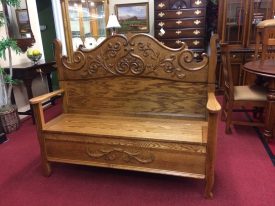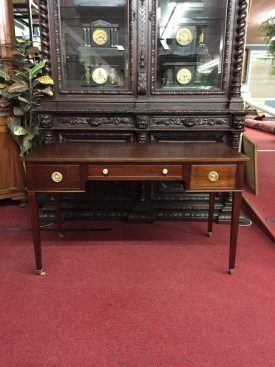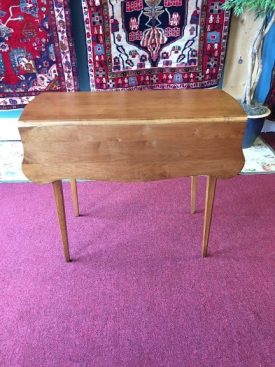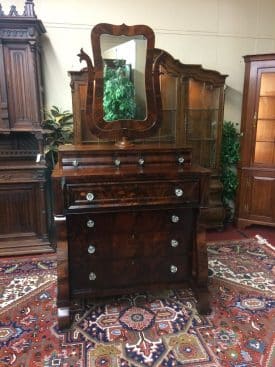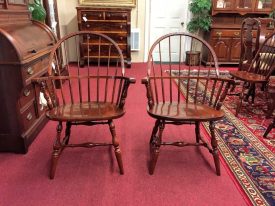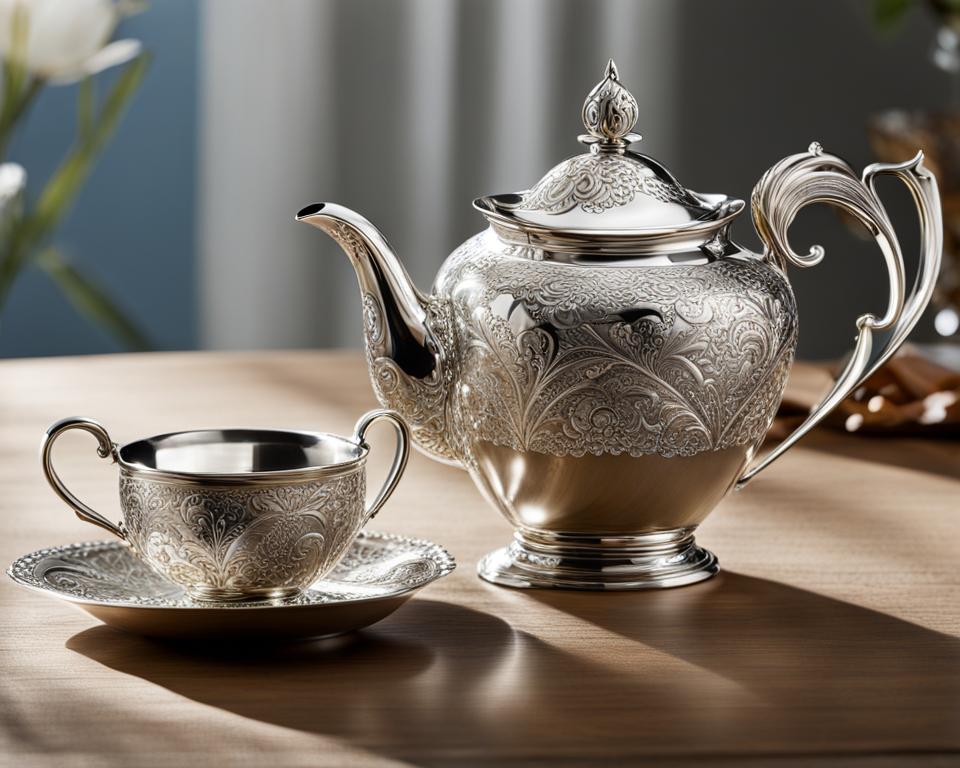French antique furniture styles have a rich history and timeless beauty. From the Renaissance to the Empire period, each era has its unique characteristics and motifs. In this comprehensive guide, we will explore the evolution of French furniture styles and provide insights into the distinctive features of each period.
Key Takeaways:
- French antique furniture styles showcase the beauty and craftsmanship of different historical periods.
- Each era, from the Renaissance to the Directoire, has its own unique characteristics and design motifs.
- French vintage furniture adds a touch of elegance and sophistication to any interior design.
- Understanding the features of each period can help you choose the perfect French antique furniture for your home.
Renaissance (1500-1610)
During the Renaissance period, French furniture experienced a profound influence from classical art and architecture. The grandeur of this era inspired furniture designs characterized by deeply carved and ornate motifs, often depicting mythological or biblical themes. This fusion of classicism with intricate craftsmanship resulted in exquisite pieces of furniture that showcased the artistic prowess of the time.
Oak and walnut were the preferred woods during the French Renaissance, chosen for their durability and rich natural hues. These materials provided a solid foundation for the intricate detailing and fine carving that defined the furniture of this period. The use of oak and walnut not only added a touch of elegance but also served as a testament to the superior craftsmanship valued during this time.
“The beauty of the French Renaissance period lies in its harmonious blend of classical elements with intricate detailing.”
One of the notable features of French Renaissance furniture was its attention to decorative details. Ornate carvings adorned cabinets, tables, and chairs, often incorporating elements of nature, such as foliage and vines. Mythological figures and religious symbols were also commonly depicted, reflecting the influence of classical mythology and the strong spiritual beliefs of the era.
The French Renaissance brought about a renewed appreciation for the classical principles of proportion and symmetry. The furniture of this period showcased a balance between elaborate ornamentation and harmonious design, resulting in pieces that exuded both opulence and elegance.
The Distinctive Features of French Renaissance Furniture:
- Deeply carved and ornate designs
- Depiction of mythological and biblical themes
- Preference for oak and walnut woods
- Fine craftsmanship and intricate detailing
- Incorporation of classical elements
French Renaissance furniture continues to captivate enthusiasts with its timeless beauty and grandeur. The classicism, intricate detailing, and choice of oak and walnut as materials make it a cherished style in both traditional and contemporary interiors.
| Features of French Renaissance Furniture | Description |
|---|---|
| Deeply carved and ornate designs | Furniture pieces featured intricate carvings depicting mythological and biblical themes, showcasing the skill of craftsmen. |
| Choice of oak and walnut | Oak and walnut woods were favored for their durability and rich natural hues, providing a solid foundation for fine detailing. |
| Blend of classicism and craftsmanship | The fusion of classical art and intricate detailing resulted in furniture pieces that combined elegance with superior craftsmanship. |
Louis XIII (1610-1640)
The Louis XIII period marked a shift towards more opulent and decorative furniture. This style, also known as the Louis XIII style, is characterized by its solid construction and distinctive geometric carving. Cherubs, scrolls, and other ornamental motifs were common decorative themes in furniture design during this era.
One of the defining features of Louis XIII furniture is its solid construction. Craftsmen of this period prioritized durability and stability, resulting in pieces that have stood the test of time. The use of high-quality woods and meticulous joinery techniques ensured the longevity of these furniture pieces.
In terms of design, geometric carving was a hallmark of the Louis XIII style. Intricate patterns featuring straight lines, symmetrical shapes, and repeating motifs adorned the furniture. These geometric carvings added depth and visual interest to the pieces, showcasing the craftsmanship and attention to detail that went into their creation.
Ornamentation played a significant role in Louis XIII furniture design. Cherubs, which are angelic figures typically portrayed as young children, were a popular decorative motif during this period. Their charming and playful presence added a touch of whimsy to the furniture pieces. Scrolls, another common decorative element, were often intricately carved into the furniture’s legs, arms, and backrests. These scrolls added a sense of elegance and movement to the overall design.
Moreover, fixed upholstery was introduced during the Louis XIII period, offering enhanced comfort and luxury. Upholstered seats and backs provided a soft and cushioned surface to support the body while maintaining the overall aesthetic harmony of the furniture.
Overall, the Louis XIII style epitomizes the opulence and grandeur of 17th-century French furniture. Its solid construction, geometric carving, and decorative motifs such as cherubs and scrolls create pieces that exude timeless elegance and sophistication.
| Features of Louis XIII Style Furniture | Examples |
|---|---|
| Solid construction | Carved oak cabinet |
| Geometric carving | Walnut armoire with intricate patterns |
| Cherubs | Carved cherub details on a wooden chair |
| Scrolls | Ornate scrollwork on a console table |
| Fixed upholstery | Upholstered armchair with detailed stitching |
Louis XIV (1640-1715)
The reign of Louis XIV was characterized by opulence and grandeur, which extended to the furniture crafted during his era. The Louis XIV style epitomized luxury and extravagance, showcasing intricate marquetry, gilding, and the use of exquisite materials like tortoiseshell and bronze. The furniture of this period featured lavish decorative motifs, including the iconic symbol of the sun and opulent animal heads.
Opulence and Grandeur
The Louis XIV style of furniture reflected the luxurious lifestyle and unparalleled wealth of the French court. The opulent designs and rich materials used in the furniture exemplified the grandeur associated with Louis XIV’s reign.
Intricate Marquetry and Gilding
Marquetry, the art of applying detailed veneers to furniture surfaces, was a prominent feature of Louis XIV style. Elaborate floral, geometric, and figurative patterns were meticulously crafted using different types of wood veneers, creating stunning visual effects. Gilding, the application of gold leaf or gold paint, added a touch of splendor to the furniture, enhancing its overall luxurious appearance.
Precious Materials
Tortoiseshell, bronze, and other precious materials were used abundantly in Louis XIV furniture. Tortoiseshell was highly sought after for its distinctive pattern and rich color, making it a prized material for embellishing furniture pieces. Bronze, often cast in intricate designs, added a touch of elegance and sophistication.
Lavish Animal Heads
An unmistakable decorative motif seen in Louis XIV furniture is the use of animal heads. These ornate carvings, often in the form of lion heads or other majestic creatures, were incorporated into chair arms, table legs, and other furniture details. The animal heads symbolized power, strength, and the nobility associated with the French monarchy.
“The Louis XIV style showcases the ultimate in opulence and luxury, with its intricate marquetry, gilding, and lavish animal head motifs. It is a testament to the grandeur and sophistication of the French court during this period.”
Régence (1715-1730)
The Régence period marked a significant transition in French furniture design, bridging the gap between the opulent Louis XIV style and the more graceful Rococo era of Louis XV. During this time, furniture exhibited distinct characteristics that set it apart from previous and subsequent periods.
The Régence style is known for its asymmetrical curves and delicate proportions, which introduced a sense of lightness and movement to furniture design. The use of cabriole legs became popular during this period, adding an elegant touch to chairs, tables, and other pieces. These curved legs, often terminating in intricate scrollwork or animal paw feet, created a sense of fluidity and grace.
Walnut and rosewood were the preferred woods of choice during the Régence period. Walnut, with its warm tones and distinctive grain patterns, added a sense of richness and depth to furniture. Rosewood, on the other hand, lent a touch of sophistication and luxury with its dark hue and fine texture.

“The Régence period introduced a new level of refinement and elegance to French furniture. With its asymmetrical curves, cabriole legs, and choice of walnut and rosewood, Régence furniture showcased the skill and artistry of its craftsmen.”
Notable features of Régence style furniture include delicate carvings, ornate marquetry, and playful motifs inspired by nature, such as flowers and foliage. Complementing the graceful curves and intricate details, lighter wood veneers were favored, adding a touch of delicacy and sophistication to the overall design.
During the Régence period, furniture designers and craftsmen experimented with new forms and techniques, setting the stage for the exuberant Rococo style that would follow. The Régence style remains highly sought after today for its timeless elegance and the harmonious blend of classical influences with innovative design elements.
The Characteristics of Régence Style Furniture:
- Asymmetrical curves
- Cabriole legs
- Delicate carvings
- Ornate marquetry
- Playful motifs inspired by nature
- Choice of walnut and rosewood
- Lighter wood veneers
| Furniture Feature | Description |
|---|---|
| Asymmetrical Curves | Characteristic feature of Régence furniture, adding fluidity and movement. |
| Cabriole Legs | Elegant curved legs with intricate scrollwork or animal paw feet. |
| Delicate Carvings | Ornate carvings showcasing skill and attention to detail. |
| Ornate Marquetry | Decorative technique using inlaid wood to create intricate patterns and designs. |
| Playful Motifs | Inspired by nature, motifs such as flowers and foliage add whimsical charm. |
| Choice of Woods | Walnut and rosewood were commonly used for their beauty and durability. |
| Lighter Wood Veneers | Veneers in lighter shades added delicacy and elegance to the furniture. |
Louis XV (1730-1770)
The Louis XV period is often regarded as the pinnacle of French furniture design. The style, also known as rococo, featured graceful and feminine lines. Furniture was characterized by exquisite details and decorative motifs such as foliage, flowers, and shells. Fruitwoods and rosewood were prominent materials used.
During the Louis XV era, furniture craftsmen embraced the rococo style, which originated from the French word “rocaille,” meaning “rockwork.” This style emphasized intricate decorative elements inspired by nature, creating an elegant and romantic aesthetic.
The Louis XV style introduced an organic and fluid approach to furniture design, departing from the rigid forms of the previous periods. Curved lines, sinuous shapes, and asymmetrical compositions became prevalent, reflecting a more natural and relaxed sensibility.
One of the distinguishing features of the Louis XV style was the emphasis on comfort. Upholstered seats and cushions provided a luxurious and inviting seating experience. The use of soft, sumptuous fabrics, such as silk and velvet, further enhanced the comfort and visual appeal of the furniture.
Fruitwoods, such as walnut and cherry, were commonly used in the construction of Louis XV furniture. These materials offered warmth and richness to the pieces. Rosewood, with its elegant grain pattern and deep reddish hues, was also a favored choice for creating exquisite veneers.
The Louis XV style incorporated a wide range of decorative motifs. Delicate floral carvings, ornate scrollwork, and intricate foliage patterns adorned the furniture surfaces. The use of shell motifs, such as scallop shells and clam shells, added a touch of whimsy and fantasy to the designs.
“The Louis XV style exemplifies elegance and sophistication. Its graceful curves and intricate details create a sense of luxury and refinement that has captivated furniture enthusiasts for centuries.” – Renowned Furniture Historian
Tables and chairs were often adorned with carved cabriole legs, which featured an S-shaped curve and ended in delicate scroll or claw-and-ball feet. This unique leg design added a sense of movement and elegance to the furniture pieces.
The Louis XV style extended beyond furniture to encompass other decorative objects, such as clocks, mirrors, and lighting fixtures. These pieces echoed the same aesthetic, with their sinuous lines, organic motifs, and luxurious materials.
Materials Used in Louis XV Furniture
| Material | Description |
|---|---|
| Fruitwoods | Walnut, cherry, and other fruitwoods were used for their warm tones and beautiful grain patterns. |
| Rosewood | Known for its elegant appearance, rosewood was often used for veneers and decorative elements. |
| Gilt bronze | Used to adorn furniture with intricate ormolu mounts and decorative hardware. |
| Marquetry | Intricate wood inlays formed decorative patterns and motifs on furniture surfaces. |
| Silk and velvet | Luxurious fabrics that were used for upholstery, adding comfort and visual appeal. |
| Porcelain | Exquisite porcelain plaques and figurines were incorporated into the design of furniture. |
The Louis XV style continues to be celebrated for its beauty, craftsmanship, and timeless appeal. Its influence can still be seen in contemporary furniture design, with designers drawing inspiration from its feminine lines and intricate detailing.
Transition (1750-1775)
In the transition period of French antique furniture styles, there was a notable shift in design influence. Inspired by the excavations of Pompeii and Herculaneum, Roman influence began to permeate French furniture design. This era, spanning from 1750 to 1775, brought about notable changes in the aesthetics and structure of furniture.
Furniture during the transition period embraced more angular lines, departing from the curvilinear forms of the previous era. The influence of Roman architecture and design can be seen in the emergence of the Greek key pattern, a repeating decorative motif that adds a touch of sophistication to furniture pieces.
Another notable change in the transition period was the thinning of furniture frames. As the emphasis shifted towards angularity, furniture became lighter and more streamlined in appearance. This departure from the ornate and heavy designs of previous periods brought a sense of elegance and simplicity to the furniture of the time.

The Greek Key Pattern
The Greek key pattern, also known as the meander pattern, is a symbol of eternity and infinity that has its roots in ancient Greece. It consists of a continuous line, typically in the shape of a rectangular key, that turns at right angles, creating a geometric design.
“The Greek key pattern adds a timeless elegance to furniture, with its symmetrical and interconnected lines. It is a versatile motif that can be incorporated into various styles, from classical to contemporary.”
During the transition period, this pattern became a popular decorative element, used in woodwork, upholstery, and ornamentation. Its presence on furniture added a touch of sophistication and visual interest, showcasing the influence of Roman aesthetics on French design.
Overall, the transition period marked a significant shift in French antique furniture styles. The influence of Roman design, with its angular lines and the incorporation of the Greek key pattern, brought a fresh and contemporary look to furniture. The thinner frames and departure from curvilinear forms added a sense of lightness and elegance to the furniture of the time.
Louis XVI (1770-1790)
The Louis XVI style represented a significant shift in French furniture design, characterized by its emphasis on symmetry and classical ornamentation. During this period, straight lines and elegant simplicity became the prominent features in furniture design, moving away from the intricate and ornate styles of the previous eras.
Mahogany, a favored wood of the time, was often used in the construction of Louis XVI furniture. Its rich warm tones and durability made it an ideal choice for creating timeless pieces. This fine wood was expertly crafted into furniture that exuded sophistication and elegance.
Neoclassical motifs such as rosettes, columns, and laurel leaves adorned the furniture, reflecting a revival of ancient Greek and Roman influences. These motifs were intricately carved onto the surfaces, adding a touch of grandeur and refinement to the pieces.
“The Louis XVI style is characterized by its harmonious proportions, disciplined lines, and graceful symmetry. The furniture from this period exemplifies the balance between function and aesthetic beauty.”
Distinctive Features of Louis XVI Style
- Straight lines and geometric forms
- Classical ornamentation and neoclassical motifs
- Symmetry and balance in design
- Refined craftsmanship and attention to detail
- Mahogany as the primary wood
Examples of Louis XVI Furniture
| Furniture Piece | Description |
|---|---|
| Marquetry Commode | A chest of drawers featuring intricate marquetry designs, often depicting floral motifs or pastoral scenes. The straight lines and symmetrical structure showcase the Louis XVI style. |
| Bergère Chair | An upholstered armchair with a square back and padded arms. The chair’s frame is often embellished with finely carved details, such as fluted legs and rosettes. |
| Tufted Ottoman | A low upholstered stool or ottoman with tufted cushioning. The ottoman’s base features carved wooden legs and delicate details, showcasing the elegant simplicity of the Louis XVI style. |
Directoire (1790-1805)
The Directoire period, also known as the Post-Revolutionary period, brought about a shift in French furniture design. This era, spanning from 1790 to 1805, was characterized by a departure from the opulence of the Louis XVI style and a move towards a more austere aesthetic.
The Directoire style showcased a sense of simplicity and refinement, reflecting the political and economic climate of the time. Clean lines and geometric patterns were prevalent in furniture design, exemplifying a departure from the decorative excesses of previous periods.
Mahogany and walnut were commonly used woods during the Directoire period, providing a rich and elegant appearance to the furniture pieces. These woods were often polished to a smooth finish, enhancing their natural beauty and adding a touch of warmth to the overall aesthetic.
Influenced by neoclassical motifs, Directoire furniture featured architectural elements such as columns, cornices, and Greek key patterns. These design elements brought a sense of timelessness and sophistication to the furniture, embodying the classical ideals that were popular during the period.
Brass was also commonly used during the Directoire period as a substitute for the more expensive gilt-bronze. This allowed for intricate detailing and ornamental accents, further adding to the overall elegance of the furniture.
Furniture Characteristics of the Directoire Period
During the Directoire period, furniture design underwent a significant transformation. Here are some key characteristics of the Directoire style:
- Simultaneous simplicity and elegance
- Clean lines and geometric shapes
- Mahogany and walnut as preferred woods
- Neoclassical motifs and architectural elements
- Use of brass for intricate detailing
Directoire Furniture Examples
Directoire furniture encompassed a wide range of pieces, including seating, tables, cabinets, and accessories. Here are some notable examples:
| Furniture Piece | Description |
|---|---|
| Directoire Chair | A straight-backed chair with clean lines and minimal ornamentation. Upholstered seat and backrest for comfort. |
| Directoire Table | A rectangular or circular table with straight legs and simple, geometric design. Often made of mahogany or walnut. |
| Directoire Console | A narrow table with slender legs, usually placed against a wall. Often adorned with neoclassical motifs. |
| Directoire Cabinet | A compact cabinet with clean lines and minimal decoration. Used for storing tableware, books, or other belongings. |
The Directoire period marked a transition towards a more restrained and refined furniture design. The use of mahogany and walnut, along with neoclassical motifs, created a sense of timeless elegance in Directoire furniture pieces.
Conclusion
The rich heritage of French antique furniture styles offers endless inspiration for interior design enthusiasts and collectors alike. From the intricate carvings of the Renaissance to the opulence and grandeur of the Louis XIV period, and the graceful lines of the Louis XV era, each style showcases its own distinctive charm and elegance.
By understanding the unique characteristics and motifs of French period furniture, you can make informed choices when selecting pieces to enhance your home décor. French vintage furniture brings a timeless allure to any space, serving as a focal point that adds character and sophistication.
Whether you prefer the classicism of the Renaissance, the ornate beauty of Louis XIV, or the intricacy of Louis XV rococo designs, French antique furniture styles can elevate your interior to new heights of elegance and refinement. Incorporate these exquisite pieces into your home, and let the timeless allure of French craftsmanship enchant your living spaces.
FAQ
What are French antique furniture styles?
French antique furniture styles refer to the different design periods and aesthetics that characterized furniture in France throughout history.
What are some examples of French antique furniture styles?
Some examples of French antique furniture styles include Louis XV style, Louis XVI style, Rococo furniture, Baroque furniture, Empire style furniture, and Art Nouveau furniture.
What materials were commonly used in French antique furniture?
Common materials used in French antique furniture include oak, walnut, rosewood, mahogany, fruitwoods, tortoiseshell, bronze, and gilt-bronze.
What are the distinguishing features of Louis XV style furniture?
Louis XV style furniture is characterized by its graceful and feminine lines, intricate detailing, and decorative motifs such as foliage, flowers, and shells.
What are the distinguishing features of Louis XVI style furniture?
Louis XVI style furniture is known for its symmetrical design, straight lines, and classical ornamentation such as rosettes, columns, and laurel leaves.
What is the difference between Baroque and Rococo furniture?
Baroque furniture is known for its opulence and heavy ornamentation, while Rococo furniture is more delicate and characterized by asymmetrical curved lines.
Where can I find French antique furniture?
French antique furniture can be found in antique stores, vintage furniture shops, and online marketplaces that specialize in antique furniture sales.
Are French antique furniture styles still popular in interior design?
Yes, French antique furniture styles continue to be popular in interior design as they add a touch of elegance, history, and timeless beauty to any space.
How can I incorporate French antique furniture into my home decor?
You can incorporate French antique furniture into your home decor by using it as statement pieces, mixing it with modern furniture for a eclectic look, or integrating it into a specific design theme such as French provincial or shabby chic.
What is French provincial furniture?
French provincial furniture refers to the furniture styles that emerged in the French countryside during the 18th century, characterized by their simplicity, rustic charm, and regional influences.

